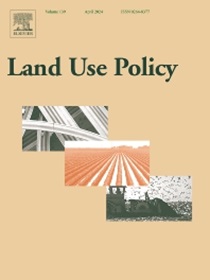Telecoupling China's rice production: features and causes
IF 5.9
1区 社会学
Q1 ENVIRONMENTAL STUDIES
引用次数: 0
Abstract
China accounts for a quarter of the world's rice production and thus significantly impacts world rice markets and food security. In recent decades, rice production in southern China has declined consistently, and the causes have been widely discussed, but the impact from rice production in northeast China has not yet been analyzed. Based on telecoupling theory, this study utilized an econometric model to explore the relationship between rice production in northeast and southern China. The results showed that northeast rice production accelerated the decline of southern rice production and the lower the profits of alternative crops to rice in the northeast and the higher the profits of alternative crops to rice in the southern, the greater the crowding-out effect, which promotes the shift of rice production to low agricultural opportunity cost regions with superior natural conditions and resource endowments. Northeast China's rice production showed an absolute crowding-out effect when rice was oversupplied and a relative crowding-out effect when rice was undersupplied. The lowest rice purchase price policy weakened the crowding-out effect but pushed up rice stock. Furthermore, the arable land requisition–compensation balance policy reversed the downhill trend in southern rice production and promoted rice abandonment. This research extends the understanding of inter-system relationships under different preconditions and policy interventions according to telecoupling theory and provides valuable insights for optimizing the spatial distribution of rice production and related policy reforms in China.

中国水稻生产的耦合:特征与成因
中国水稻产量占世界总产量的四分之一,对世界大米市场和粮食安全产生重大影响。近几十年来,中国南方水稻产量持续下降,其原因已被广泛讨论,但东北水稻产量的影响尚未得到分析。本研究基于远耦合理论,利用计量经济模型对东北和南方水稻生产的关系进行了研究。结果表明,东北水稻生产加速了南方水稻产量的下降,东北替代作物利润越低,南方替代作物利润越高,挤出效应越大,促使水稻生产向自然条件和资源禀赋较优的农业机会成本较低的地区转移。东北水稻生产在供大于求时表现出绝对挤出效应,在供大于求时表现出相对挤出效应。最低收购价政策削弱了挤出效应,但推高了大米库存。耕地征收补偿平衡政策扭转了南方水稻产量下降的趋势,促进了水稻退耕。本研究扩展了对不同前提条件和政策干预下系统间关系的理解,为优化中国水稻生产空间分布和相关政策改革提供了有价值的见解。
本文章由计算机程序翻译,如有差异,请以英文原文为准。
求助全文
约1分钟内获得全文
求助全文
来源期刊

Land Use Policy
ENVIRONMENTAL STUDIES-
CiteScore
13.70
自引率
8.50%
发文量
553
期刊介绍:
Land Use Policy is an international and interdisciplinary journal concerned with the social, economic, political, legal, physical and planning aspects of urban and rural land use.
Land Use Policy examines issues in geography, agriculture, forestry, irrigation, environmental conservation, housing, urban development and transport in both developed and developing countries through major refereed articles and shorter viewpoint pieces.
 求助内容:
求助内容: 应助结果提醒方式:
应助结果提醒方式:


